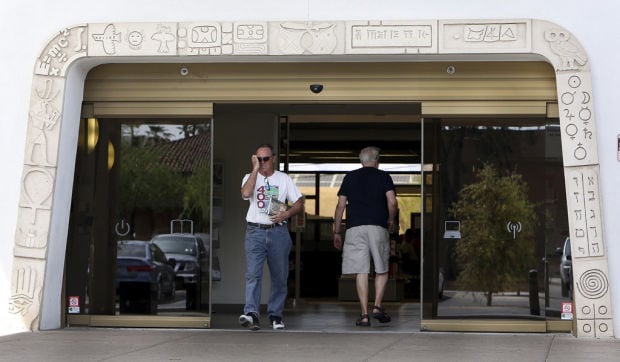Ancient and modern symbols greet patrons entering the Murphy-Wilmot Branch Library.
The main entrance to the building, 530 N. Wilmot Road, features a stone archway with almost two dozen carvings of symbols from various cultures.
The archway was created by Tucson sculptor James Savage, and the symbols, which have been part of the award-winning building since its opening in 1965, represent "man's progress in knowledge and writing," according to a library document.
The sculpture is meant to serve as "a welcome to all who will partake of the riches inside," according to the document.
Among the carvings are a Mayan time glyph and Native American petroglyphs found in caves in New Mexico and Colorado that symbolize compass points, stars and a span of life. A tablet carving features Hebraic lettering representing the Ten Commandments, cuneiform writing spells out the word Persia, and Albert Einstein's formula for energy are all part of the archway. Several Egyptian symbols are carved in the stone, including the god Thoth, who is believed to be the creator of hieroglyphics, the Ankh symbol, and the Mystic Eye, an amulet that is meant to bring strength and good health.
Because visitors frequently ask about the symbols, the library created a booklet describing each symbol for curious patrons, said branch manager Daphne Daly.
Schools often use the sculpture as a clue for scavenger hunts, and teachers talk about the symbols and meanings when their classes visit the library, Daly said.
The original architect for the library, Nicholas Sakellar, wanted the entryway to be a timeline depicting the history of the written language, said his son, Dino Sakellar.
"That's why you see it starting off with petroglyphs and the Egyptian icons," he said.
Dino Sakellar, also an architect, worked on a renovation of the library completed in 2011 and decided to incorporate some modern-day symbols into the design.
The "at" sign, recycle symbol and Wi-Fi symbol are some of the modern symbols sandblasted on the library's sliding glass doors.
Those symbols help continue the timeline of the archway, Dino Sakellar said.
Got an oddity?
Have you noticed something while driving through Tucson that has piqued your curiosity? Or is there a piece of Old Pueblo history you've wondered about? Drop us a line, and we'll look into it.
Contact the Star newsroom at oddity@azstarnet.com or 807-7776
The original architect for the library wanted the entryway to be a timeline depicting the history of the written language.
Architect Dino Sakellar,
son of original architect, Nicholas Sakellar
Contact reporter Veronica Cruz at vcruz@azstarnet.com or at 573-4224.





